How it all began – The first five years
A Personal Recollection by Terry Hastings
The five mile Steam Railway and an electrified eight mile main line from Ryde to Shanklin are now all that remain of a railway system which once extended its tentacles over 55 miles of mostly rural Wight. The first line opened in 1862 between Cowes and Newport but it was not until 1900 that Ventnor received its second railway and the Island rail complex was complete.
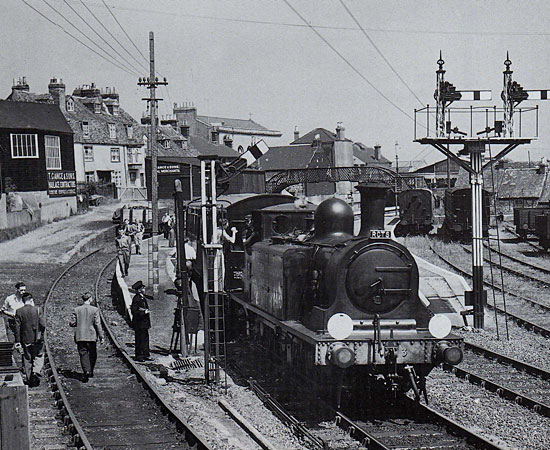
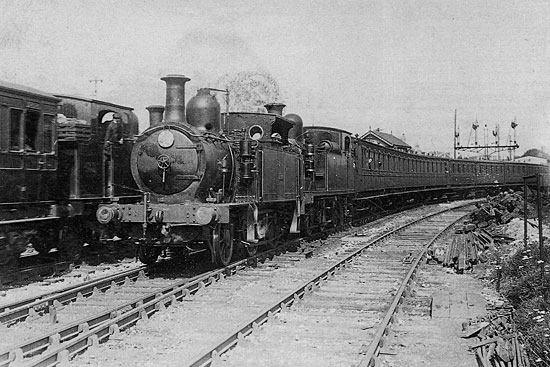
By the mid 20th century, after two World Wars and a lengthy depression, it was not surprising that rural branch lines came under the spotlight and their economic status was in question. The 1950’s saw lines to Bembridge, Freshwater and the very last line opened to Ventnor, all closed. The Island’s steam hauled railways were becoming a sad reflection of their former glory but still retaining a fascination for historians and enthusiasts as the Island’s isolation had seen the retention of antiquated locomotives and carriages, most of which had arrived as hand-me-downs from the mainland.
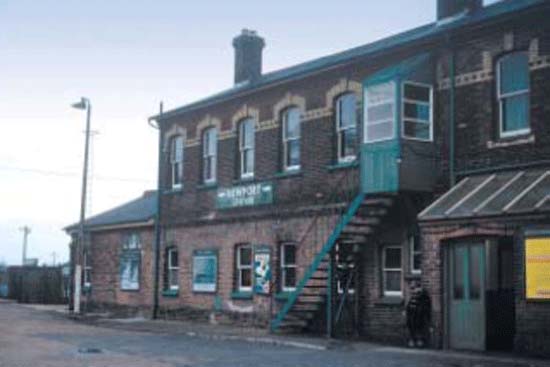
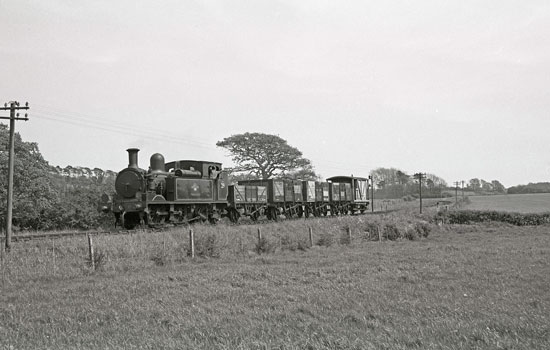
In 1965 the remaining lines from Cowes and Ventnor to Ryde were under threat of closure and there was interest from various parties in trying to preserve some of the Island’s, by now, unique hardware. Similarly an eleventh hour rearguard action to prevent closure was mounted and a scheme to operate the Cowes line with private investment was launched by an organisation known as Vectrail.
The story of the Isle of Wight Steam Railway begins with one of those interested parties, Ron Strutt a mid teens chap who had a few years earlier tried to purchase one of the old Island engines from British Rail … but had failed. Ron and friend Iain Whitlam called a meeting in south London during late ’65 to gather interest from like minded people in possibly preserving something of the old Island railways. Iain coined the name Wight Locomotive Society and they agreed to try and secure at least one ex London & South Western Railway O2 class engine and possibly a carriage or few.
Whilst the more optimistic felt it may be possible to lease back from British Railways part of the shortly-to-be-closed railway, others were more realistic and suggested static preservation may be possible; but if the Vectrail scheme came to fruition some limited form of operation could happen. Sights were set at a realistic level but all around them other individuals and groups were telling the World what they were going to preserve from the impending graveyard of historic stock.
The pressure groups and politics had some effect on the railways of Wight; the line from Cowes to Ryde remained open until February 1966 and only part of the Ventnor route, that from Shanklin to Ventnor itself closed in April the same year.
A modernisation programme was to see the end of the old steam trains and the line from Ryde Pier to Shanklin was electrified to accommodate ex London Transport tube trains. The last steam train operated the delayed 10.12pm service from Shanklin to Ryde St John’s Road on 31st December 1966.
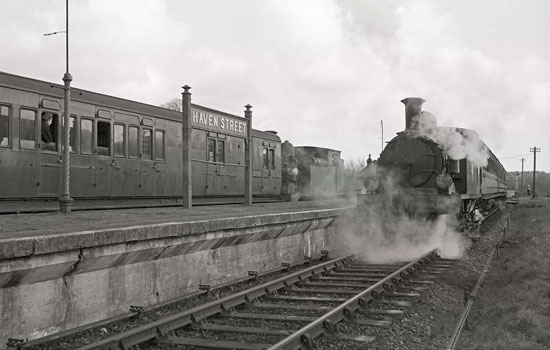

The Wight Locomotive Society had mustered its troops. Armed with appeal leaflets and collecting tins their presence at the last week of steam trains could not be missed. What many did not know at that time was that a few weeks earlier a budding wildlife artist David Shepherd had a conversation in the offices of publisher and lifelong railway enthusiast Ian Allan at which Mr Shepherd expressed an interest in helping one of the growing number of groups throughout the U.K. appealing for funds to save steam engines. The reply he received was, to quote, “David, if you have £500 to spend, why don’t you buy an 02 class tank engine?” A visit to the Island with W.L.S. members in November 1966 sealed the deal and the fighting fund was much nearer to raising the £900 needed to buy a locomotive.
The Isle of Wight Steam Railway probably owes its existence to this chance conversation as, with one exception, all of the other attempts to secure engines and rolling stock from the Island sank without trace. The exception was an individual who secured one coach on behalf of Canadian interests but even this lost its way and eventually came into W.L.S. ownership.
So, after the game the final score: One 02 class locomotive called CALBOURNE, two ex South Eastern & Chatham carriages and three ex London Brighton & South Coast vehicles. Over the next couple of years a few ancient goods wagons and a crane also joined the, by now, unique collection.
But what of operations? The locomotive was located at Ryde St John’s Road as it had been used during 1967 to assist with engineering work on the newly electrified Shanklin line and was effectively stranded when the connection with the old Cowes track was severed. The coaches were at Newport station together with the remaining redundant engines, wagons and carriages, all of which were in the sights of the scrap team who relentlessly worked their way through the lines leaving little but soggy asbestos and globules of molten glass which had fallen from burning carriages.
The prospects of the Vectrail group (remember them?) waxed and waned with the moon, its greatest hope was the Sadler Rail Car and its sponsor who may be persuaded to fund the revival of the Cowes-Ryde railway. But like all such schemes, whilst the local authorities and British Railways were patient, in the end it’s the cash that counts! The W.L.S. on the other hand had seen the writing on the wall and after a little internal wrangling agreed to prepare a case to secure a short piece of line on which to store and possibly operate its collection, its exact length dependant on available funds, In 1969 the engine was moved by road from Ryde to join its train at Newport and work started in earnest to make it operational… it had to be done as the Society hoped to make its new base at Haven Street, some miles away by rail.
Autumn 1970 and Vectrail was laid to rest and CALBOURNE was in steam; local negotiations allowed limited operation around the Newport station site to test and hone our operating skills. These negotiations had taken some time to fructify and certain clandestine and nocturnal movements of stock may have taken place … perhaps the root of some ‘ghost train’ stories which later came to our ears!
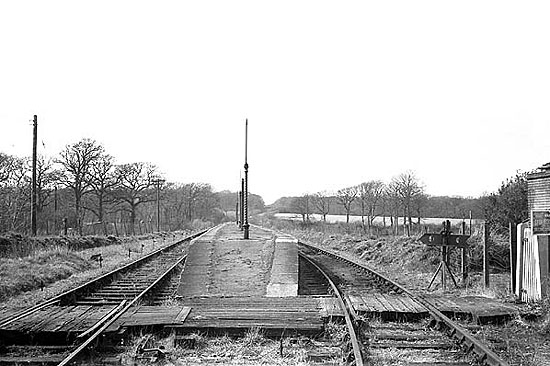
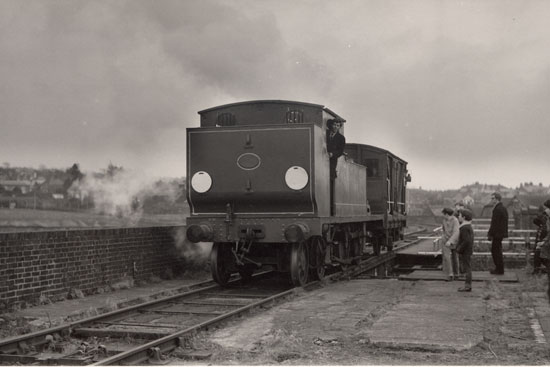
Negotiations also took place with both the local Council and British Railways regarding the purchase of a chunk of line and various other equipment such as water tanks, trackwork and buffer stops, all of which were going to be needed if a railway was to be run. The W.L.S. raised funds like never before, the continued existence of the historic stock depended on it and sufficient was raised to pay the deposit on 1 and 5/8 mile of line from Wootton (with road access) to Haven Street also with road access and both on a bus route! There was little of engineering interest on the section and with a little t.l.c. it was hoped a train would run in a short while.
All this was at the planning stage when on Monday 18th January 1971 notice to quit Newport station arrived – it all had to be gone by 25th!
Although not unexpected, and some preliminary work on the track to Haven Street had been carried out, it came as a shock. A meeting was called at a pub near the Fishbourne car ferry terminal that night, mainlanders and locals formulating a plan of action … After closing time and perhaps with the help of a little alcohol things didn’t look so bad. Tuesday saw frantic action, teams started to load ‘stuff’ onto wagons and vans (preservationists gather lots of ‘stuff’), and others headed off for Cowes on the remains of an old Ryde Pier Tram to gather steel rail keys – these to replace the wooden ones which had kept home fires burning between Newport and Havenstreet for the past few years. Posters were printed and nailed to trees and posts all along the line warning trespassers to be wary of train movements over the next few days. It came as quite a shock to many a dog and owner when the tram, laden with track materials and water tanks bore down on them through the grass covered tracks at 30 miles an hour, the liberal use of the hand operated klaxon was a perverse joy of the driver on these trips.
There were two main obstacles on the line to Havenstreet. The first just yards from base camp, was the draw bridge which carried the lines over the River Medina. It had not been opened for years and we had avoided crossing it during operations around the station. It was inspected by our engineers and found to be intact. Theft of bearings was feared but unfounded. A rather fatalistic attitude prevailed amongst our youthful number. If it all falls in we walk away and deny everything, remembering to wear running shoes on the day.
The second obstruction was more manageable. There had been an ongoing clay problem at Wootton for years and it was sited just a few feet short of the line we were about to purchase. This slippage and heave had to be crossed to give rail access to our line. A small team of Boy Scouts, their Leader and one other chappy went to look at the job on Thursday. By Friday some of the clay slip was cleared and the track, which had a distinct kink in it, packed and ballasted to provide a solid base. The team went away very pleased they had done their best but it rained – Oh how it rained – and by Saturday, just 24 hours before it needed to carry trains, the lines lay suspended in fresh air surrounded by a sea of mud. The tram arrived a little before midday Saturday laden with timber packing, in fact the skeletal remains of numerous old wagons that had previously been broken up at Newport, plus a few hundred weights of ballast scooped from the four-foot on the way. Frantic was the action and a sort of raft was created under the track but there was no means of load testing so the team leader undertook to standby when the first trains crossed, although exactly what action he could have taken if the train toppled I don’t know but from his location he was certainly going to go down with the sinking ship!
Sunday 24th January 1971, a date that will go down in history, well in the history of the Isle of Wight Steam Railway at least … it was our first day or was it our last? At Newport it dawned bright, pumps were lifting water from the track drains into locomotive and other water barrels, and last minute preparations to run four steam hauled trains to Havenstreet were well under way. The water situation had been caused by the impending sale of the railway land to the local authorities. As part of this process the water supply, which the W.L.S. had been using for four years without charge, was cut off and the only alternative was to use the track drains as a reservoir by blocking the outlets. You will recall it rained on Friday night and by Saturday most of Newport station was under water up to two feet in places.
The locomotive crew was at first under the supervision of former driver Tony Tiltman. His ex boss Ivor Davies from Ryde Works also gave advice along with WLS member John Wenyon from Eastleigh Works. Later model maker Don Young joined for a trip but as the day wore on Bob Huxtable and Tom Jackman were left to their own devices with a guest appearance of this author on the footplate of the very last trip. This resulted in a stop at Whippingham to ‘blow up’ which all goes to prove I’m no better with a shovel than a pen!
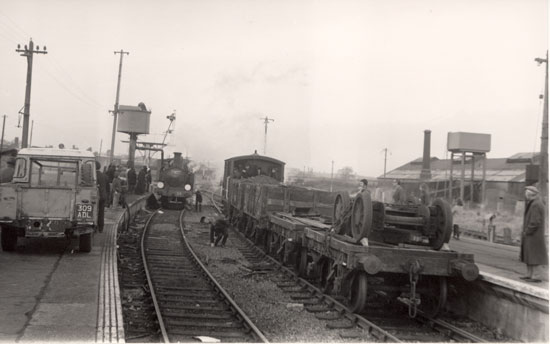
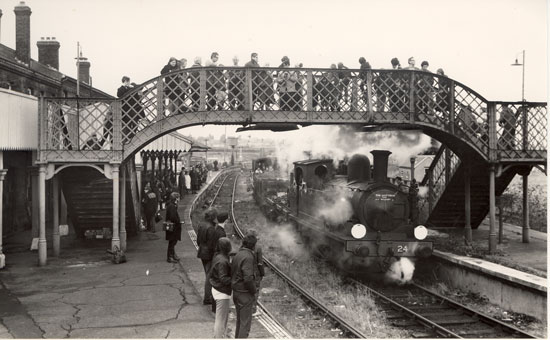
The WLS had a commitment to its members to tell them when the move was to take place. We were in the middle of a postal strike and it was years before texts and e-mail. Press Officer Richard Newman and friends did their very best to contact as many as possible and he was able to issue them with tickets for the very last train from Newport. George Wheeler was the person who had undertaken training of guards and shunters over the previous months and he set out the timetable and method of working for the ‘move’. It was planned to run two passenger trains at 10.40 and 12.15 of three carriages each, then two goods trains (we had by now acquired a number of additional goods vehicles from the defunct Vectral), and all this was interlaced around ‘Rail Motor Car’ (the tram) and light engine workings. Somewhere in the middle of all this was a stop at the one time Royal Station of Whippingham where a letter was set down for onward conveyance to Her Majesty The Queen. She must have remembered it, as she came to visit us at Havenstrett 33 years later!
The schedule was all very optimistic but how often does moving home go exactly to plan? At about 8.30pm the last Rail Motor left Newport. The station deserted and silent, had seen its last train. The tram crew were fighting a battle of which few knew in the euphoria of the day, they had run out of gaffer tape to stick a leaking fuel pipe and one of their number was holding the connection together, the transmission had given up the ghost hours ago and was held together with a succession of bent 6″ nails whose lifespan depended on the use of the right foot of the driver! They had been booked into Haven Street at 5pm but it was gone ten when the crew arrived in the local pub to a great cheer from the crowd and a rendition of The Runaway Train on the piano by the landlord.
We had arrived, day one at the Isle of Wight Steam Railway was over and we all slept well for the first time in a week.
The scrap merchants really did start work on the following week and progress was rapid. We managed a couple of trips with the tram from Haven Street to Smallbrook to ‘recover’ sundry items and another team were at Newport marking up the various pointwork which we had purchased. Local deals also included an amount of signalling wire and equipment which we were lacking. To be honest, at Haven Street we were lacking most things. All the stock was crammed into the up and down loops as there were no sidings, the building was boarded up, no water, no electric, but we did have an old concrete p/way hut complete with stove; what a way to run a railway!
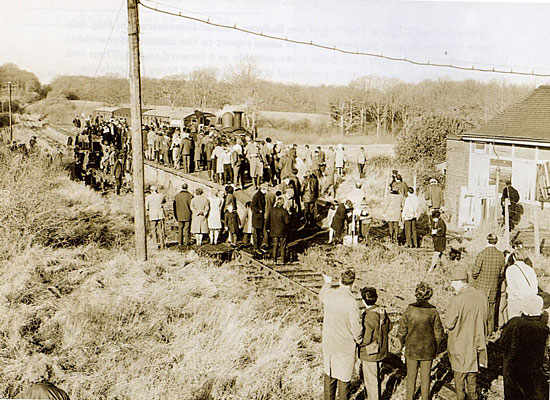
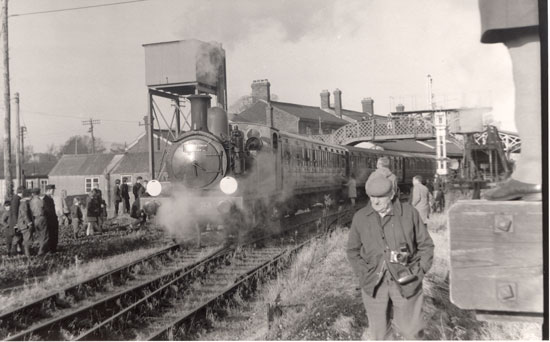
The intention was to open for the public at Easter. That was less than ten weeks away if I recall. Boards came off the building and the water turned on; there was no electric to turn on so oil lamps were the order of the day. A pump was mounted on a flat truck and was shunted to an overbridge where river water was pumped directly into the locomotive. A form of pull/push working was devised with the brake van leading towards Wootton. CALBOURNE located on the down hill end was in communication with the guard through a Heath-Robinson bell system, although I am not certain if this was in place on that very first day.
Sadly the spring was not kind, that rain returned and parts of the line became rivers. This delayed even the most rudimentary track work planned so that by Easter it was decided only to operate as far as Woodhouse Crossing, a little short of half distance.
But it happened! On Easter Monday CALBOURNE and its train of three ex-LB&SCR carriages puffed their merry way to Woodhouse and back and carried around 1000 passengers in the process.
In recent months there has been much head scratching about the timetable for those first days; search as we may there is no trace. Nor were Guard’s journals used for some months, but a recent conversation with George Wheeler, our one time Operations guy brought it all back… “Well it was very much a case of when Jacko (Tom Jackman, driver) said he’s got steam, we go!” and so we did!
Terry Hastings – 25-05-10
‘THE MOVE’ – 24TH JANUARY 1971
The move to Havenstreet was reported eloquently by Richard Newman in the Spring 1971 issue of Wight Report. Here is the text verbatim, accompanied by photos published in ‘The Last Train’, the booklet prepared for The Last Train Walk event on 23rd January 2011.
TO HAVEN STREET! by Richard Newman
At 8.30p.m on 24th January, the last South Western O2 rumbled across the Medina Drawbridge, Newport, high above the river and its quays, ending another transport chapter in the Island’s history, for the rails it ran upon were to be taken up for scrap almost immediately afterwards.
Some 12 hours earlier on that Sunday, we had arrived at Newport Station to find “CALBOURNE” in fine form, standing next to the water column at the Cowes end of the platform. Bob Huxtable and Tom Jackman, of the Loco Dept., had already been working for more than 3 hours to prepare the engine for her historic journeys, and pressure was now building up to a satisfactory level for the move to begin.
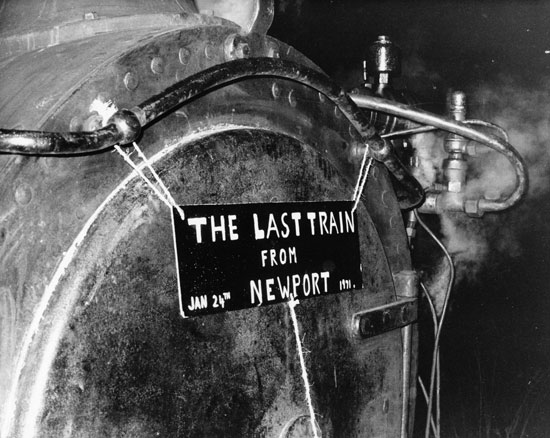
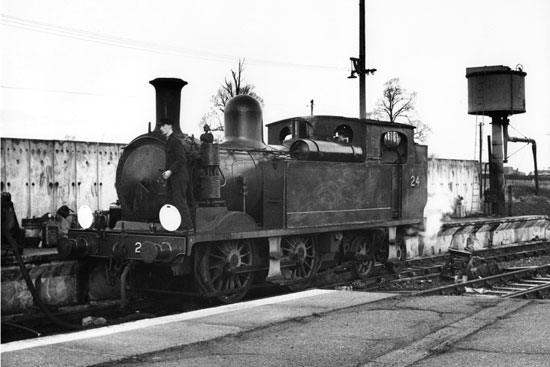
Meanwhile, David Perry and Martyn Mullins, who had been “rostered” as guards during the final preparations made on the previous evening in a well-known Newport hostelry, were preparing the 3 set of former L.B.S.C.R. carriages which were to form the first train of the day. The carriages stood at the northern end of the yard, where they had been moved a couple of weeks previously to facilitate oiling of axle-boxes. George Wheeler, who was appointed in overall charge of the day’s operations, had drawn up an official “Special Notice” for the use of all operating staff, which provided for 4 runs to Haven Street with the engine, together with a couple of additional journeys to be made with the former Ryde Pier Tram.
Consequently, at 10.am. the tram, driven by Terry Hastings and John Wenyon, pulled away from Newport to make an exploratory trip over the disused line, which had been the scene of much activity during the previous days. By this time, crowds had gathered at Newport Station and the Press reporters and photographers were already well-employed taking records of the occasion. Temporary “block posts” were set up for telephone messages to be sent from Haven Street to the Railway Medina public house, Newport, giving the ‘all clear’ for the train to proceed.
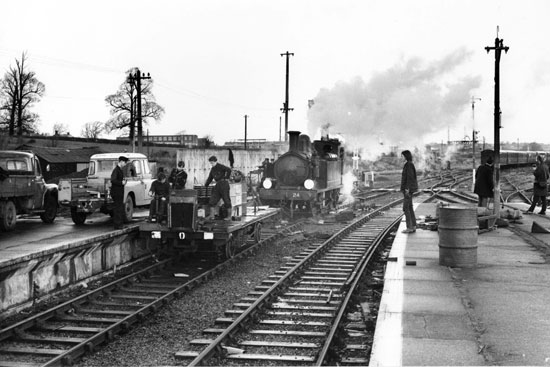
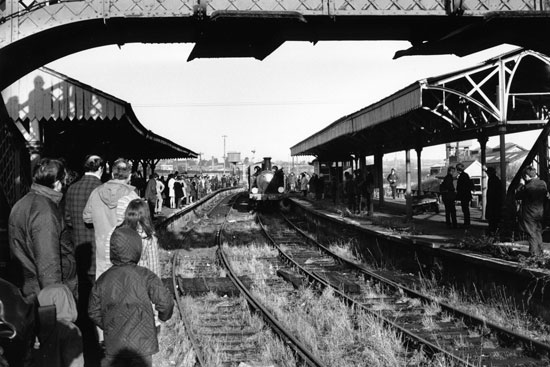
At about 10.40, “CALBOURNE” ran up the yard and coupled up to 3 carriages which were then hauled through the Up platform on to the Viaduct for a preliminary test run, after which water had been taken. As no difficulty was apparent, the train picked up the ‘passengers’ who had been standing patiently on the Down platform. Travel on the train had been restricted to Society members and special guests, and indemnity forms were thus prepared for completion by all who wished to make the journey. Before departure, a small ceremony was held on the platform for Miss Hannah Winter, ardent railway supporter from Haven Street, who was presented with a bouquet by 7-year old Michelle Cobb of Bembridge to commemorate the occasion.
And so, with a blast on the guard’s whistle from David Perry, acknowledged by a “hoot” from the engine, we were away – although slight delay was experienced in persuading a small dog not to stand on the track. As we crossed the viaduct and ran into the tunnel beneath Fairlee Road, it seemed almost as if trains had never stopped running – except for the crowds! At every vantage point along the line, there appeared a sea of faces – mainly local residents of course as the enthusiast world in general had not heard of the manoeuvre. One Society member in Fairlee Road added to the event by displaying a large green flag and Union Jack from his garden! Progress up the bank was excellent – over Halberry House and Mews Lane Crossings & through the avenue of pine trees towards Whippingham to prepare for the steepest gradient of all. Beyond Whippingham, the train passed the horses and cattle in a field later depicted on B.B.C. Television – these creatures had obviously never seen a train before!
As we reached the summit of Wootton Bank, the train was brought to a stand on wet rails in the depths of the damp cutting – which is never penetrated by sunlight in winter. This was done intentionally prior to crossing the slip. Former loco Foreman Ivor Davis and “operating officer” George Wheeler clambered down from the engine and with Terry Hastings and Kim Chalkley, who had positioned themselves at the cutting, they anxiously watched as the engine was coaxed inch by inch past the embankment slip, which had been further swollen by the torrential rain of the previous 24 hours. The engines and carriages were gradually eased over the buckled track, witnessed by further crowds watching from Station Road Bridge.
The most difficult part of the run had been successfully accomplished! From Wootton to Haven Street steam was cut off for the downhill run through the woods and into the station, where another large crowd of people of all age groups eagerly awaited the occasion and it is said that Sunday School attendances suffered badly as a result! Following due ceremony for the Press photographers, the engine took water ready for the return “light” to Newport. The carriages were berthed beyond the road bridge to the east of the station and the engine set off, pausing only for a moment after crossing Wootton slip. What a fine sight it made as it coasted downhill over Halberry House Crossing into Newport, running bunker first into the brilliant winter sunshine.
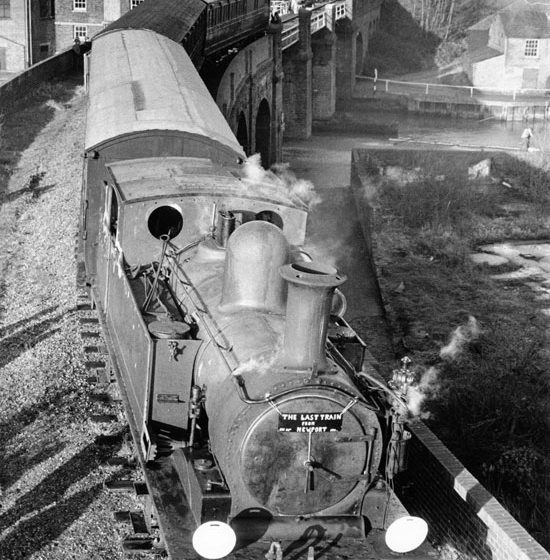
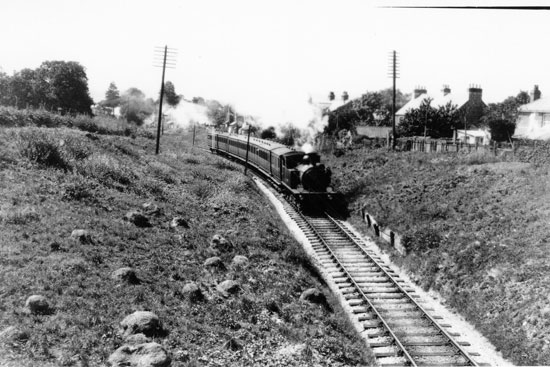
The schedule originally planned had to be revised and it was some time before the next run was made, but the opportunity was taken to marshall the goods wagons into two trains; No. 24, coupled to several loaded coal wagons and the L.S.W.R. Brake Van left Newport at approx. 2.35p.m. carrying on board a despatch bag which contained a letter to Her Majesty The Queen. The document commemorated the fact that this was the last train to call at Whippingham Station, once used by guests of royalty travelling to Osborne House. As the train ground to a halt at Whippingham (closed to passengers in 1953, and now a private residence), Alderman Mark Woodnutt, the Island’s M.P., was waiting to receive the despatch bag from the engine crew (Bob Huxtable and Tom Jackman) and to convey it onwards to Buckingham Palace on the following Tuesday. Society officials posed for photographs on the buffer beam of “CALBOURNE” with Ald. Woodnutt, who was then welcomed aboard the engine for the remainder of the journey to Haven Street.
After some time the engine and Brake Van ambled through the countryside back to Newport. Little time was wasted upon reaching the station however, for daylight was fast fading. At 5.45pm., No. 24 departed from the ‘Up’ platform with three S.E.C.R. carriages well-laden with another load of passengers. Accommodation was strictly limited on this set for No. 4149, the Society’s most recent acquisition, was devoid of all seats, whilst several compartments in the other coaches had been loaded with seat cushions and other miscellanea. A spirited run was made to Haven Street, where, in the darkness, passengers and onlookers one by one drifted away. One carriage (6375) had its electric lighting in working order at the start of the journey, but there was little power in the batteries and the lights grew dimmer as the train proceeded on its way.

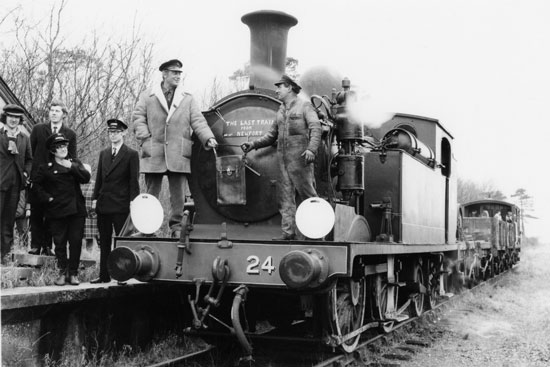
The tram, which had been stationed at Haven Street for most of the day as ‘water carrier’, was sent back to Newport ahead of the engine at this time to collect the remainder of the miscellaneous equipment – which included a platform trolley and the pump used for replenishment of water supplies on the engine. Working on a time interval basis, the engine returned with caution some time later and arrived at Newport just after 7.15pm. to take on water and collect the remaining items – 2 wagons, the 6-wheel Midland crane D429 and its match truck and the 1898 L.S.W.R. van (56046). After engine and tail lamps had been found and placed in position, the train was ready to leave and, at 8.30pm. by the Town Hall clock, the motley assortment of wagons, loaded with a remarkable accumulation of materials, screeched out of the Up platform behind “CALBOURNE”. A small crowd of Society members watched from the platform, cheering the train on its way. A shrill hoot from the engine, followed by a series of long blasts as 24 rumbled over the viaduct ended a 109-year association which the town of Newport had had with its railway since the inauguration of the Cowes & Newport railway in 1862. At this hour of the evening most of the people who had watched the day’s proceedings had been driven home by rain, but two ladies hurried from Quay Street to the Viaduct and waved enthusiastically as the train passed overhead. Still hooting, the engine hauled its load into the tunnel and rushed the steep gradient on the other side.
This was perhaps the most sentimental journey of all – reminiscent of many a solemn ‘Last Day’ – for this was the final train out of Newport; the Society had at last vacated the Island capital. No. 24 made steady progress up the bank, but a stop was made just beyond Mews Crossing to inject. George Wheeler, now acting as guard, walked back along the line to protect the train in accordance with Regulations, for the tram was to follow from Newport some 20 minutes later. As it happened, the tram suffered a mechanical failure on the way and was only coaxed through to Haven Street by Steve Day and John Wenyon after repairs had been carried out using parts of the diesel pump it was carrying! Meanwhile, pressure had again increased on “CALBOURNE” to allow her to proceed. A local resident had thoughtfully provided a Tilley lamp to pinpoint the exact position of the slip at Wootton and had again sanded the wet rails to ease our passage. The vintage crane, formed into this train, was considered to be the next most awkward vehicle to cross the slip by virtue of its 6-wheeled rigid wheelbase but it rode the distorted track in a most satisfactory manner. With an acknowledging hoot, “CALBOURNE” ran downhill as far as the Haven Street distant signal, where a special stop was made to pin down brakes.
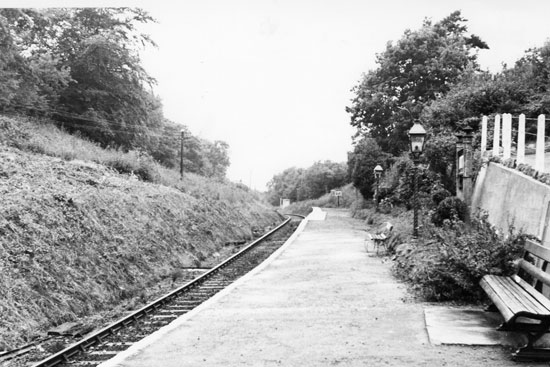
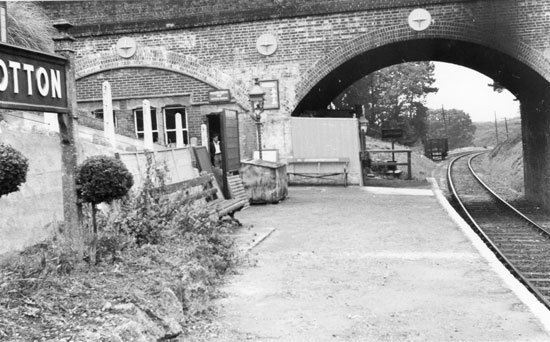
The rainswept woods echoed with the clanging buffers and couplings on the old wagons and the hiss of steam from the engine as the train restarted to run the final few hundred yards into the platform, where another Tilley lamp swung from a post in the wind – a welcome signal through the darkness. At 9.50pm. the train came to a stand at Haven Street, whilst the tram eventually arrived at 10.30pm., having been delayed by its mechanical troubles. Our entry into the ‘White Hart’ public house shortly afterwards, to the strains of suitable “railway” piano music from the resident pianist proved that the villagers of Haven Street would not forget the day that their railway “came back”!!
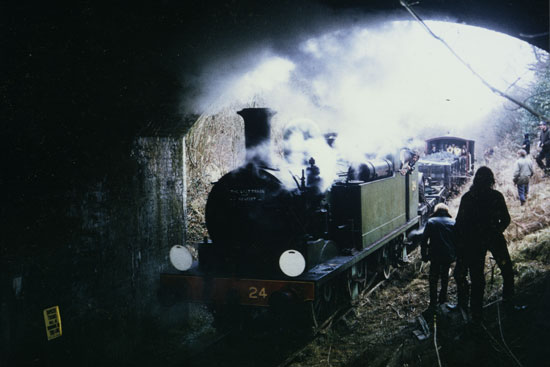
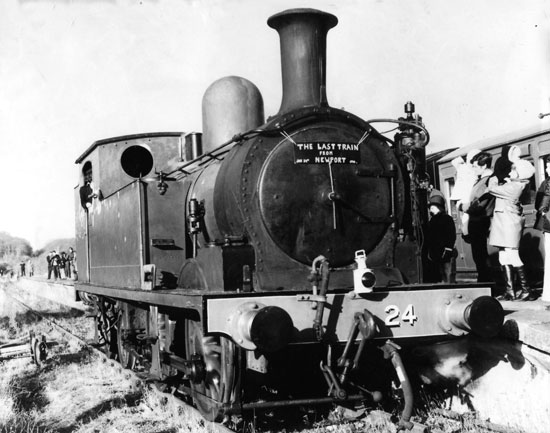
A day which had made history for the Wight Locomotive Society was thus concluded most successfully with the major obstacle, Wootton Embankment Slip, conquered. Local newspapers went to town in their reports of the day’s events – with headlines such as “Scrap Merchants Beaten at Newport” (The News) and “Hundreds Watch Last Trains from Newport” (I.W. County Press). On 2nd February (later than anticipated) three gangs from Messrs. T.W. Ward of Sheffield, the scrap merchants, commenced work from Newport on uplifting the track with alarming speed. By the end of the month rails had been taken out on the Cowes – Wootton and Haven Street – Smallbrook Junction section with only parts of Newport Yard (and of course Haven Street – Wootton) remaining intact. We can not yet be complacent about our present position at Haven Street for capital raising must still continue, but we have achieved what the pessimists said we could never do – establish ourselves at Haven Street Station.
Richard Newman
February 1971
Article first published in Wight Report –
The journal of The Wight Locomotive Society – Spring 1971